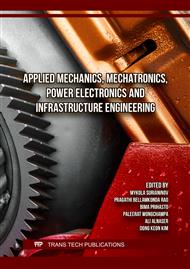[1]
S.Y. Choi, B.W. Gu, S.Y. Jeong, C.T. Rim, Advances in Wireless Power Transfer Systems for Roadway-Powered Electric Vehicles, IEEE Journal of Emerging and Selected Topics in Power Electronics, 3 (2015) 18-36.
DOI: 10.1109/jestpe.2014.2343674
Google Scholar
[2]
V. Pichet, A Review of Wireless Power Transfer, ENGINEERING TRANSACTIONS. (2021).
Google Scholar
[3]
Vatsala, A. Ahmad, M. S. Alam, R. C. Chaban, Efficiency enhancement of wireless charging for Electric vehicles through reduction of coil misalignment, IEEE Transportation Electrification Conference and Expo (ITEC). (2017) 21-26.
DOI: 10.1109/itec.2017.7993241
Google Scholar
[4]
M. Mohammad, S. Choi, Z. Islam, S. Kwak, J. Baek, Core Design and Optimization for Better Misalignment Tolerance and Higher Range of Wireless Charging of PHEV, IEEE Transactions on Transportation Electrification. 3 (2027) 445-453.
DOI: 10.1109/tte.2017.2663662
Google Scholar
[5]
A. Ahmad, M.S. Alam, Y. Rafat, S. Shariff, Designing and demonstration of misalignment reduction for wireless charging of autonomous electric vehicle, eTransportation. 4 (2020) 10088.
DOI: 10.1016/j.etran.2020.100052
Google Scholar
[6]
H. Nong, J. Lin, Design of loosely coupled inductive power transfer systems for instrumented wheelset, 2009 9th International Conference on Electronic Measurement & Instruments. (2009) 1-670-1-674.
DOI: 10.1109/icemi.2009.5274779
Google Scholar
[7]
Y. Zhang, Y. Lin, S. Lin, W. Gao, L. Chen, W. Chang, W. Hu, C. Yu, An implementation of an automatic adjustment power transfer position wireless battery charging system for mobile devices, 2017 IEEE 6th Global Conference on Consumer Electronics (GCCE). (2017) 1-2.
DOI: 10.1109/gcce.2017.8229412
Google Scholar
[8]
J.L. Villa, J.F. Sallan, J. Osorio, A. Llombart, High-Misalignment Tolerant Compensation Topology For ICPT Systems, IEEE Transactions on Industrial Electronics. 59 (2012) 945-951.
DOI: 10.1109/tie.2011.2161055
Google Scholar
[9]
E. Ayisire, A. El-Shahat, A. Sharaf, Magnetic Resonance Coupling Modelling for Electric Vehicles Wireless Charging, 2018 IEEE Global Humanitarian Technology Conference (GHTC). (2018) 1-2.
DOI: 10.1109/ghtc.2018.8601806
Google Scholar
[10]
A. Ahmad, M. Alam, R. Chabaan, A Comprehensive Review of Wireless Charging Technologies for Electric Vehicles, IEEE Transactions on Transportation Electrification. 4 (2018) 38-63.
DOI: 10.1109/tte.2017.2771619
Google Scholar
[11]
F. Musavi, W. Eberle, Overview of wireless power transfer technologies for electric vehicle battery charging, IET Power Electronics. (2014) 60-66.
DOI: 10.1049/iet-pel.2013.0047
Google Scholar



